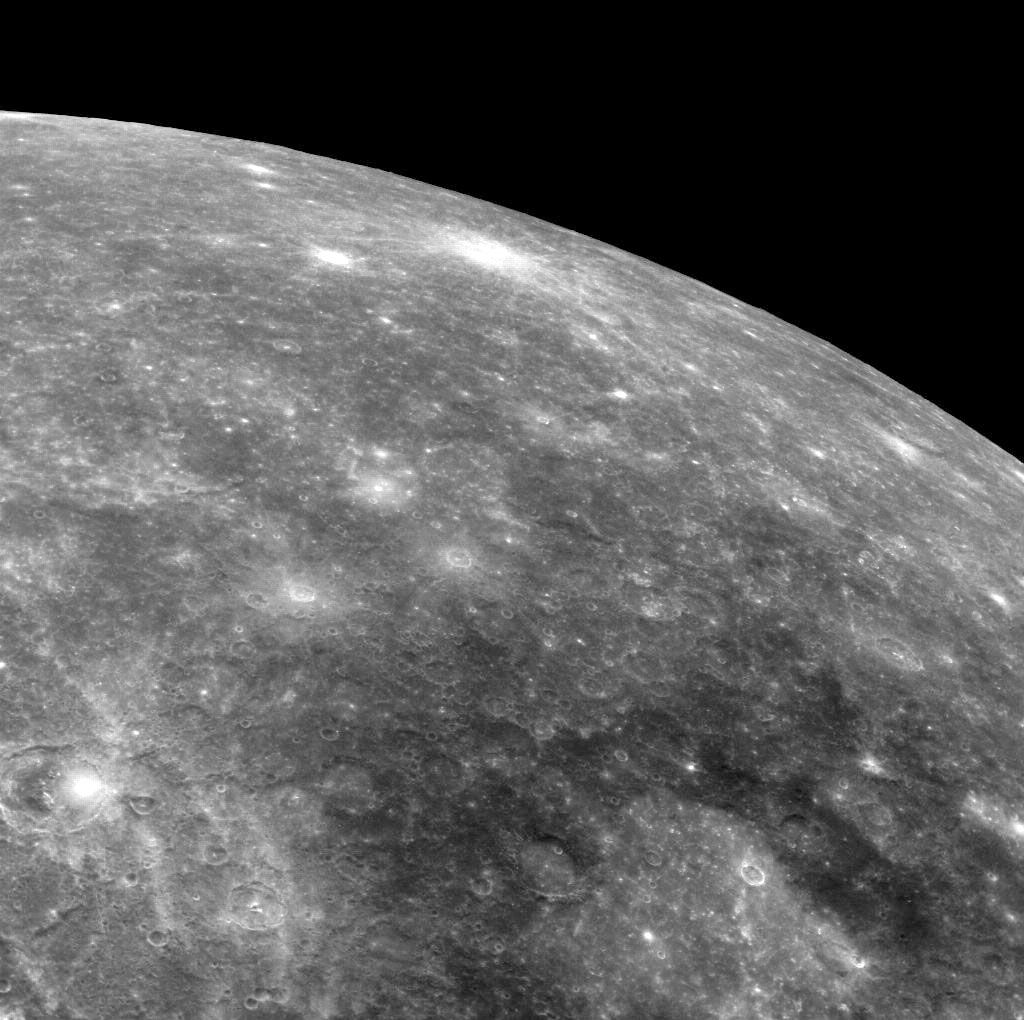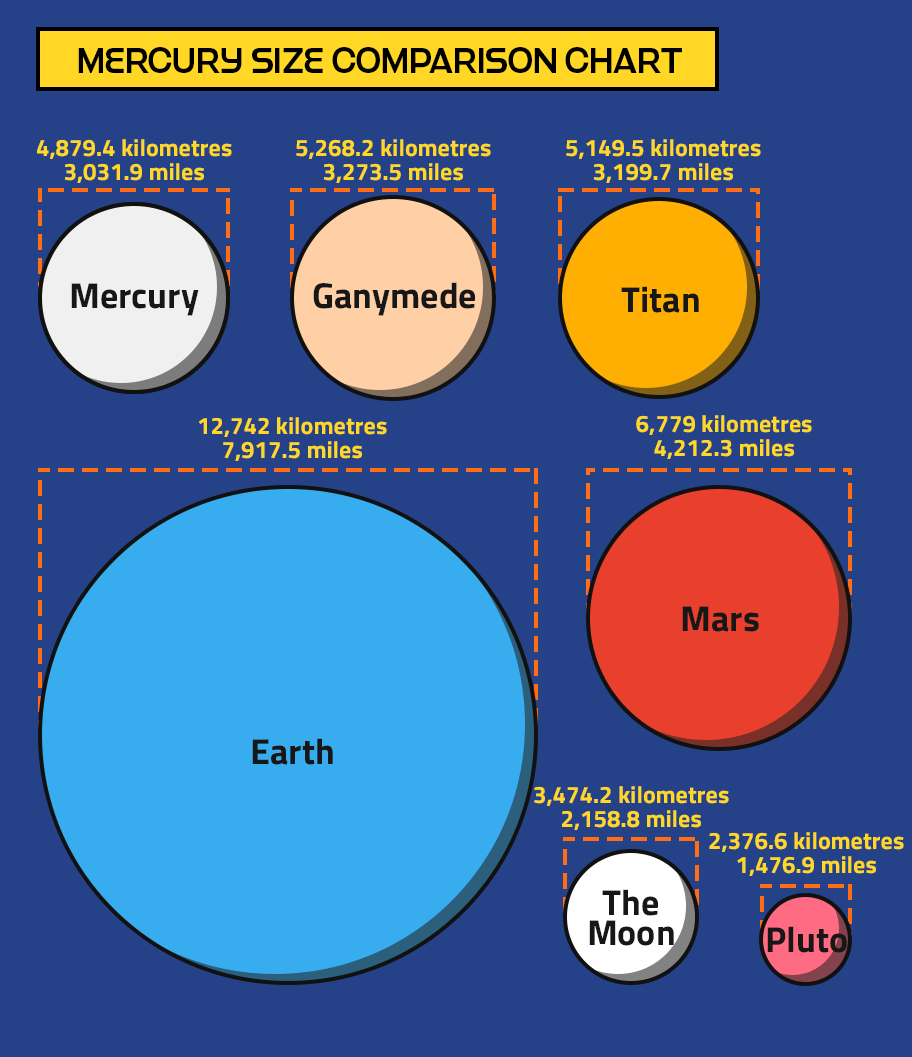Fourteen Facts about Mercury
Situated almost on the doorstep to the Sun, Mercury whizzes around its nearby star while getting barbecued on one side and freezing on the other. It may be small, but it's also fascinating. So fascinating in fact that here are 14 fascinating facts about it!
Mercury's days are very long, and also very confusing!
Mercury has a diameter of 4,879 kilometres (3,302 miles). It is about a third of the size of Earth. There are even two moons in the solar system larger than Mercury. These are Ganymede, which orbits Jupiter and has a diameter of 5,268 kilometres (3,272 miles) and Titan, which orbits Saturn and has a diameter of 5,149 kilometres (3,200 miles). That's an exciting fact to start with, isn't it? Here's a picture to make it even more exciting.
Mercury is one of the brightest objects in the sky
In the night sky, only the Sun, the full Moon, Venus, Jupiter and Mars are brighter than Mercury. Okay, that's half of the solar system, but Mercury is brighter than the other half (Saturn, Uranus, Neptune and so on) and any stars that lie beyond the solar system. Despite its apparent magnitude (that's the fancy way of saying brightness), it isn't always easy to spot. As it is so close to the Sun, it rises and sets with it. This means it can only be seen just before the Sun has risen or just after it sets.
Mercury has been observed since ancient times
As Mercury is visible from Earth with just a pair of eyes, people from olden times were able to stand and stare at it for their own entertainment and amusement. You don't need instruments like binoculars or telescopes or trumpets to see it. The Romans named it after their god of commerce and communications, and all the things that are linked to it. Stuff like shopkeeping, buying and selling, messaging, goods deliveries, and even stealing. The equivalent god in Greek mythology is Hermes.
Mercury does not have a moon
Mercury is one of only two planets in the solar system without a moon. The other is Venus. The most likely reason for Mercury not having a moon is due to it being so close to the Sun. A moon would either have to orbit it very closely, or it would just fall into the Sun and sizzle away.
Mercury is NOT the hottest planet in the Solar System
Despite being the closest planet to the Sun, Mercury is not the warmest. Venus is warmer. In fact, Mercury can be one of the coldest planets in the Solar System. Temperatures on Mercury can reach 430 °C (800 °F) on its sunny side, but drop down to a finger and toe numbing -180 °C (-290 °F) on its night side. Venus however is 471 °C (880 °F), no matter where you are on it. And if you are there, you'd be cooked.
Mercury is the most cratered planet in the Solar System
There are thousands of craters on the surface of Mercury and so far, 414 of them have been named. The discovery of craters on Mercury's surface occurred in 1974 when Mariner 10 became the first spacecraft to fly past it and take pictures. Prior to that, astronomers weren't sure whether or not Mercury would be cratered. What they saw from Mariner 10's photos was a surface which looked very similar to Earth's Moon.

Mercury has no measurable atmosphere
The lack of atmosphere on Mercury means that sunlight and heat cannot be spread through it. This gives the planet a dark sky regardless of whether it's day or night. Not having an atmosphere is also partly why the planet gets so cold at night and why it has so many craters. On planets with atmospheres, meteors heading for them usually burn up in it. If they're heading for Mercury, they head straight for an impact with its surface. Even though it doesn't have an atmosphere, Mercury has a very thin exosphere composed mostly of atoms blasted off its surface by solar wind and micrometeoroid impacts.
Mercury's craters are named after dead famous people
Mercury's craters are mostly named after people who have achieved fame in the world of arts, such as in music, literature, painting and acting. The rules around naming craters are that a person needs to no longer be living and they need have been famous for over 50 years. It's a bit of a shame that they'll never know that they were well-known enough to become a crater on Mercury.
Two space missions have visited Mercury. Two will become three in 2025.
Mercury is the least visited of the Inner Planets. Only two space craft have so far been there. Mariner 10 went there in 1974 when it flew past it three times, twice in 1974 and once in 1975. It's now likely to still be orbiting the Sun. MESSENGER reached Mercury in 2011 and remained in orbit of it until 30th April 2015. It now lies in pieces on the surface of Mercury after being sent to crash into it after running out of fuel. Mercury is due to receive a third visitor soon when BepiColombo enters orbit of it in December 2025.
Mercury has a short, speedy trip around the Sun
As Mercury is the closest planet to the Sun, it has the shortest orbit and travels the fastest of all planets. It travels at a speed of 48 kilometres a second or 172,800 kilometres per hour (30 miles per second or 108,000 miles per hour). It takes only 88 days for Mercury to orbit the Sun, meaning that a year on Mercury is 88 days long.
Mercury's days are very long, and also very confusing!
It takes 58 days for Mercury to spin once on its axis but as the planet will also have travelled quite a distance around the Sun by the time this has happened, it affects how the Sun rises and sets there. After the Sun rises on Mercury at the start of a new day, it appears to linger over the horizon for a while before setting again. It then rises higher into the sky, and depending on your location on Mercury, might appear to go back and forth and side to side before setting again. This cycle take 176 days as Mercury has to travel around the Sun two times and rotate on its axis three times for everything to be back in their starting positions. I'm so confused. This is all because Mercury is tidally locked in a 3:2 spin-orbit resonance. That's it, I have a headache. I think the next fact needs to be an easier one before I need to go for a long lie down.
The Sun appears bigger on Mercury than on Earth
If you were able to stand on Mercury, the Sun would appear three times larger than it does on Earth.
I can't think of an intro here. It's a fact about Mercury being closer than Pluto
Mercury is about 100 times closer to the Sun than dwarf planet Pluto.
The middle of Mercury is surprisingly large
Mercury has a much larger core than one would expect of such a small world. It is made up of partially molten iron which gives the planet a weak magnetic field. Its comparatively large core makes Mercury the second most dense planet in the Solar System. The densest is Earth.






